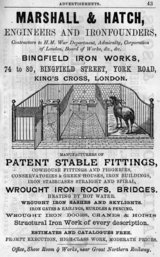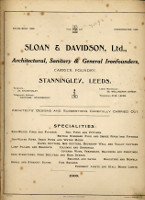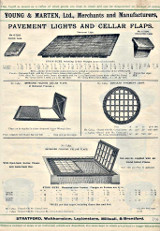-

Brooks Thomas & Co. streetcar ads
O'Connell St., Dublin, 1928

Brooks Thomas & Co., Builders Providers,
Sackville Place, 1972
—Dublin City Council
|
Banner,
London [?-1892-?]
- Edward Gregson Banner
- Cranham Hall, Essex County [1854]
- 11 Billiter Square, London [1879]
- "Notice is hereby given, that the Partnership heretofore
subsisting between the undersigned, Elizabeth Hutton and
Edward Gregson Banner, at No. 25, Watling-street, in the
city of London, under the firm of W. B. Hutton & Sons,
has been this day dissolved by mutual consent. All debts
due to and from the firm will be received and paid by the
said Edward Gregson Banner. —Dated this 12th day of
November, 1852." —The Gazette
- "Edward Gregson Banner & Sarah Caroline his wife v.
John England; Francis Blake; William Newton; and Hawkesley Hall "
—University of Houston, C78 1865
- "Appellant: Owners of the barque Amelia. Respondent:
John Banner and Edward Gregson Banner, both of 11 Billiter Sq,
City of London, owners of the brig Susan Bayley.
Subject: Collision between said vessels on 7 Oct 1872
Lower Court: High Court of Admiralty of England" —National Archives
- Wholesome houses, an exposition of the Banner system of
sanitation, 1882
- UK 1885 patent No. 15138: "Securing coal hole plates", or
long form "FOR IMPROVEMENTS IN MEANS FOR FASTENING OR
SECURING COAL-HOLE-PLATES, OR PLATES OR COVERS FOR OPENINGS
FOR LIGHTING AND VENTILATING PURPOSES"
- Banner's Self-Fastening Coal Plates and Frames in Laxton's Builders' Price Book for 1892
- Borough Engineering Works Ltd,
Luton [?-1901-1936-?]
- W. Brass, jun.,
London [?-1833-?]
- British Luxfer Syndicate Ltd,
London [1898-1929]
-
British Prismatic Light Ltd,
London [?-1904-1905-?]
- "BRITISH PRISMATIC LIGHT LTD., London; manufacturers of Maximum
Light Glass, a combination of Lense and Prismatic projections; sole
agents, Currie & Co. Ltd., 4 North St David street; Telegraph,
'Cement, Edinburgh'; Telephone 133 & 178; Depóts,
Heriothill, Scotland st.. and Morrison street stations, Edinburgh;
Tower st. and Junction Bridge station, Leith" —Post Office Edinburgh and Leith directory · 1904-1905
-
Brooks Thomas & Co Ltd,
Dublin
- Burt & Potts,
Westminster [?-1843-1908-?]
-
H. Chappell & Co.,
London
-
Cretestone Ltd
- King's Bldgs, Lydney, Glos GL15 5HE
-
M. Fitzgerald & Co.,
Dublin
- General Luxfer Prism Company, Limited,
[?-1900-1907]
-
Greener & Co,
Sunderland [1885-1921]
- Former Wear Flint Glass Works
- 1858 Founded as [James] Angus and [Henry] Greener
- 1869 Angus RIP; Renamed Henry Greener
[Flint Glass Works?]
- 1882 Greener RIP
- 1885 Bought by James Augustus Jobling;
Renamed Greener & Co.;
New trademark
- 1921 Produced PYREX; shortly renamed James A. Jobling and
Company
- 1973 Taken over by Corning
- 1975 Renamed Corning Ltd
- "From 1878, the company put more effort into making less
intricate items such as pavement lights and slabs of glass and
this was carried on by his son Edward until 1884." ...after 1887...
"Soon, the company was producing over 600 domestic items in all
colours, as well as commercial products, such as pavement lights
and glasses and lenses for ships, railways, lighthouses, and
tramcars."
—Greener Pressed Glass
- Henry Greener of the Wear Flint Glass Works —English Pressed Glass
-
Wm Halford,
2, Wynatt Street, London E.C. ("And at: Warrington")
[?-1886-1901-?]
Hammond Lane

|
-
Hamilton & Co.,
London
- Rd No 3,859, "Transmitting Light into Apartments",
dated October 1, 1878 to Frederick Hamilton &
Frederick Alma Hamilton
- Court case against the Hamiltons patent infringement heard
before High Court (judgement with costs entered for Hayward Brothers)
[1879]
- Award to "Hamilton & Co., Leadenhall Street, E.C., for
Prismoidal Pavement and Floor Lights" [Croydon, 1879?] —The
Journal of the Royal Society for the Promotion of Health. 1886;
7: 417-423
- "HAMILTON AND CO., Harrowgate Road, E. The prismoidal lights
of this firm are well known, the lenses being made to reflect the
light at different angles, whilst sectional convex lenses fixed
between the prismoidal ones radiate the light vertically. The
application of these lights to practical uses is exhibited in a
great variety of ways, and very excellent methods of adjusting
heavy pavement lights, cellar flaps, etc., by equilibrium and
rolling motions with the minimum amount of physical exertion,
and without damage to the lights, are also shown."
—The British Architect, Volume 25, April 9, 1886
- Fading of the Light —Two Years at Margaret Street:
- "Hamilton & Co. engineers & metal merchants,
17, Fenchurch St, EC" —1882 London PO Directory
- "Hamilton & co. pavement light mnfrs, 101,
Leadenhall St, EC" —Morris's 1884 Business Directory
- Hamilton's patent prism —
An Encyclopaedia of Architecture, Historical, Theoretical, & Practical, 1891
-
Hammond Lane Foundry Co Ltd,
Dublin [?-1902-1963-?]
- Pearse Street, No. 111A
- "The Hammond"
- "'Hammonds' of the Dublin. — Business revived by
Scotsman David Frame in 1902. He gifted 86 acres of Bray Head for
the development of public park in 1922 and eventually established
Irish Steel in the 1930s." —Grace's Guide
- "grants for equipment and expansion" —National Archives of Ireland
- "Despite the evidence to the contrary, Dubliners were
devoted to the notion that the city was being over-run by country
people and foreigners, and were particularly devoted to the notion
that migrants were displacing Dubliners in employment. ... If they
faced opposition in the city, that opposition was not confined
merely to the streets, but also surfaced in political debate. In
March 1907, a speaker at a meeting of Dublin Corporation complained
that the Hammond Lane Foundry employed "only Scotsmen and niggers".
In reply the manager pointed out that the workforce was comprised
of 87 Irishmen, 15 Scots and one American, and that the employment
of the foreigners was the consequence of the lack of specialist
skills in the local labour market." —National Archives of Ireland
- "''Lissadell'' was sold in working order to Hammond Lane Foundry
in 1954 and survived until broken up at Manorhamilton in 1957."
—SLNCR Leitrim class [locomotives], Wikipedia
- "The Hammond Lane foundry, which was chosen by the de
Chastelain Commission as one of the suitable locations for
decommissioning of terrorist guns." —Caption, Rusting Cistern,
Greg Clarke, Flickr
- "The last foundry to operate in Ringsend was Hammond Land
Foundry. The firm is still in the area, and since 1898 has
become one of the biggest metal recycling works in Ireland,
but there is no foundry anymore. Evidence of this famous
foundry can still be found on lamp posts and manhole covers
in the area." —Four Sisters, Kurt Kullmann
- "The Irish Builder, 25 March 1916. For some insight
into one Dublin foundry in this period see National Library; P.
1920; B. Murphy, The Hammond Lane Foundry Co. Ltd 1902-1952
(Dublin, 1952)" —Ireland and the Industrial Revolution
- "Repercussions were felt within twenty-four hours. The first
major victim was the Hammond Land Foundry in Pearse Street, the
country's largest. One day after the ban went into effect, the
company announced that it would be forced to close down, and put
some two hundred employees out of work. The cause was the lack of
coke for the furnaces. The news sent shock waves through the
country's industrial landscape. It was the first complete closing
of any major industry since the fuel shortage began in the early
stages of the Second World War." —Ireland's Arctic Siege of 1947
- Hayward Brothers,
London
- John Healey Ltd,
London
-
Howard, Sons and Parsons,
London [?-1908-1914-?]
-
Improved Pavement Light Company Ltd
[?-1906-?]
- Rd No. 48677
- Lightwells and their variants —Faded London
- "...Companies Registered during the Year ended the 31st
December 1906...": Improved Pavement Light Company, Ltd:
Date of Registration, 3 Aug;
Nominal Amount: £12,000;
Nominal Amount of each Share: £1;
Issued or to be issued otherwise than for Cash:
Nominal Amount, 7,000, Considered as paid up, 7,000;
Issued subject to Payment in Cash: 2,500"
—Parliamentary Papers, House of Commons and Command, Volume 76
- J. A. King & Co, Ltd,
London
-
A. J. Lely & Son,
12 Railway Approach, London [?-1894-1900-?]
- Lely's Semi-Prism Lights
- This pavement light turned into a promotional item is etched
"A. J. Lely & Son / Pavement Light / Manufacturers /
12 Railway Approach / London Bridge". Embossed on the glass is
"LELY'S No 152" and "LONDON".
- Queensland PO Directory 1894-95 (Wise):
"Lely & Son's Prismatic Lights".
- New Zealand's 1898 Index to Commercial Prospectuses: "Pavement light manufacturers". —World Vital Records
- New Zealand PO Directory 1898-99 (Wise):
"A. J. LELY & SON, Engineers. 12, RAILWAY APPROACH,
LONDON BRIDGE, S.E. Manufacturers of all descriptions."
- Queensland PO Directory 1900 (Wise):
"A. J. Lely and Sons' Prismatic Lights".
- Builders' Price Book for 1903
- Faded London has a photo of an iron pavement light panel
with rectangular lenses; the frame is embossed
"LELY'S SEMI PRISM LIGHTS".
- Another panel is shown at ipernity, taken "Finsbury, London EC1, 15 April 2015. (image 3119)".
- Another panel at ipernity
is embossed "LELY'S SEMI-PRISM LIGHTS, 12 RAILWAY APPROACH,
LONDON S.E." and "LELY'S CLIMAX LIGHTS"
- I have a battered promo pavement light for trade; pictured right
is my new upgrade.
- Lenscrete,
London
[?-1959-1967] (acquired by Luxfer Pavement Lights Ltd)
- Luxfer Ltd,
London [1929-1940-?]
-
Mackenzie & Moncur Ltd,
Balcarres Street, Edinburgh,
"c.1850's - 1970's ?"
- "The firm of Mackenzie & Moncur Ltd was founded in Edinburgh
in 1869 by Alexander Donald Mackenzie and George Greig Moncur..."
Archives Hub UK
- Abridged catalogue: Mackenzie & Moncur, Ltd.: hothouse builders, heating and ventilating engineers..." —archive.org
- Street Lighting Catalogue —EdinPhoto (Peter Stubbs)
- "Specialists in hothouses and conservatories - Sefton
pool Skibo. Tulialan, Kew, Ardgillan Castle, Ireland. Also
pavement lights / drain covers."
—Scottish Ironwork (archive.org)
- "Main works in Balcarres Street, Edinburgh. Dates of
Operation: c.1850's - 1970's? Also owned a foundry in Slateford Road.
Agents in Glasgow And Edinburgh. Major Glasshouse builders in
Edinburgh specialising in large structures and mechanical systems
(heating etc.) for hothouses. Contempories and rivals of Charles D.
Young in Edinburgh. Range of products: Conservatories, hothouses,
gates, fountains, garden chairs, iron cisterns, espaliers, summer
houses, verandas, pavilions, wrought iron boilers & fittings,
gratings, pipes, finials, crestings, radiators, domestic engineering
appliances, iron stairs. Specialised in the manufacture of pavement
'lights' and municipal castings."
—Scottish Ironwork (archive.org)
- "Mackenzie Brothers, later Mackenzie & Moncur, were a firm
of Edinburgh ironfounders and heating engineers..."
—Mackenzie Brothers History, Simon Cornwell
- Mackenzie & Moncur Vault Light in Edinburgh —Shadows of a Forgotten World
- Catalog ca1900,
PDF —compiled from their catalogue by Brian Roberts, Chairman CIBSE Heritage Group
- Pavement light at UK Architectural Antiques Ltd
- MacLean & Co.,
145 Bath Street, Glasgow
Marshall & Hatch

1886 Laxton's Price Book
|
- 30 Albert Street, Manchester
- W. Magson, Midhurst Road, Benton, Newcastle
-
Marshall & Hatch,
74 to 80, Bingfield Street, York Road, King's Cross,
London [?-1886-?]
-
Maximum Light Window Glass Ltd,
London [?-1905-1906-?]
- "Maximum Light Window Glass Ltd., London; manufacturers of
maximum light glass, a combination of lens and prismatic
projections; agents, Currie & Co. Ltd., 4 North St David
street; Telegraph, 'Cement'; Telephone, 273 and 274; Depôts,
Heriothill, Scotland Street, and Morrison St. stations, Edinburgh;
Tower Street and Junction Bridge station, Leith" —Post Office Edinburgh & Leith Directory · 1905-1906
-
Patent Pavement Light Company Ltd,
London [1886-1916?]
- 181, Queen Victoria Street, F.C.
- "Company No: 22200; Patent Pavement Light Company Ltd.
Incorporated in 1886. Dissolved before 1916" —National Archives
- "There is to be seen here a dioptrical lens (Wilson's
patent), in which instead of a plane reflector, a convex
is adopted, by which it is claimed that a greater diffusion
of light is obtained. A comparative test is given showing
in the one case the reflection of the light in a direct focus
whilst in the convex form the rays of light are diffused
equally over the whole area." —The British Architect, V25, 1886
- "Patent Pavement Light Company, Limited.
On the 16th inst, this company was registered with a capital of
£6000, in £1 shares, to acquire and work the letters
patent granted to Robert Wilson for the improvement in lenses for pavement reflectors, deck lights, and other like uses. The subscribers are:—
| Hy. Harker, 37, Walbrook, public accountant |
25 Shares |
| E. James, 11, Staple-inn, surveyor |
25 |
| T. Wilson, Wallsend |
25 |
| S. Lowe, 182, Strand, journalist |
20 |
| T. Teasdale, 11, King William-street, iron merchant |
25 |
| J. H. Biddles, 23, Brixton-road, clerk |
10 |
| Wm. Young, 26, Southwark-street, hardware merchant |
10 |
Registered without special articles."
— The Engineer, Volume 61, Feb. 26, 1886
-
Pavement Light Co.
[?-1884-?]
- "In Hayward v. Pavement Light Co. (r), the plaintiffs
were owners of a patent for "Improvements in Pavement Lights,"
having for its object lights so constructed as to divert the rays
of light in an inclined direction into the rooms which it is
desired to light, by using glass moulded to as to consist of an
angle or series of angles. The defendants used lights of glass
moulded in the shape of a curve; it was held, that the
defendants had infringed." —The Law and Practice of Letters Patent for Inventions, 1897
- R. H. & J. Pearson,
London [1840s-1940]
- Pilkington Brothers Ltd,
St Helens, Lancashire [c.1826-present]
- St Pancras Iron Work Co.,
London [1854-1916]
-
Sloan & Davidson,
Carrick Foundry, Stanningley, Leeds
[?-1890-1925-?]
- Incorporated 1905
- "Architectural, Sanitary, and General Ironfounders"
- "Pavement Lights and Stall Board Lights"
- Telephone: 32, STANNINGLEY; Telegraphic Address: "CASTINGS,"
STANNINGLEY
- Leeds Warehouse: 58, WELLINGTON STREET; Telephone: 2199, LEEDS.
- Bought by J. & J.W. Longbottom Ltd; still in operation
Sloan &
Davidson

Trade Mark |
|  |
|  |
|  |
|  |
-
Stangate Glass Works,
Lambeth, London [?-1840s-?]
- See Christy's coal plate
- "Very little is known about the glassworks of J. F. Christy at
Lambeth. Surviving examples attributable to his firm all date from
the late 1840s, when he was producing painted opaline glass in the
manner of Richardson's of Stourbridge, who were the leading producers
of painted glass at this time. Like Richardson's, he produced
ornamental wares inspired by Greek vases and by contemporary French
opaline glass." —British Museum
- "Mr. Christy, of the Stangate glass-works, having kindly
contributed a series of specimens of the actual materials
employed in the manufacture of flint-glass, as used for phials,
chemical vessels, barometer and thermometer tubes, &c.,
as well as of the glass itself in the successive stages of the
process, that process was detailed. The materials, essentially,
are silica, in the form of fine sand, from Lynn, in Norfolk,
or from the tertiary strata of Alum Bay, in the Isle of Wight;
potash, in the form of pearlash; or soda, in that of purified
soda-ash; and protoxide of lead, in the form of litharge;
red-lead being sometimes employed, in which case a portion
of oxygen gas is liberated during the process. The result of
the intimate mixture and complete fusion of these materials,
together with a portion of broken glass of the same description,
for about forty-eight hours, is flint-glass." —Abstract of a Lecture on the Nature and Physical History of Glass
- Tonge & Taggart Ltd,
Dublin [1869-1988]
Young & Marten

|
-
UNILUX Pty Limited
- H. Wilson & Co,
London [?-1889-1897-?]
- George Wright,
Rotherham [?-1903-1914-?]
-
Young & Marten, Ltd.
Stratford, London [1884-?]
- "William Young 1872-1882 or later, Young & Marten by
1884-1899, Young & Marten Ltd from 1900. At 36 Broadway,
Stratford, Essex by 1874-1878 or later, 100 Broadway by
1882-1886, 5 Romford Road, Stratford by 1882-1884, Caledonian
Works, Romford Road 1886-1922 or later, Romford Road by 1928
to 1982, Grove Crescent Road, Stratford 1982-1988 or later.
Merchants and manufacturers, white lead and oil and colour
warehouse, later also artists' suppliers and stained glass'
artists." —National Portrait Gallery, British artists' suppliers, 1650-1950 - Y
- Grace's Guide to British Industrial History
- The Visual Telling of Stories: Trade Catalogues, Young & Marten Building Supplies and Decor
- Caroline Simpson Library & Research Collection
|